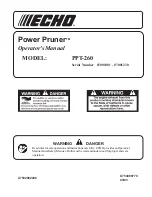
11
ENGLISH
(Original instructions)
u
Position the bolt (2a) into the recess (3b) on the riving
knife (3) and push towards the rear of the riving knife until
it locks into position, as shown in figure G.
Saw blade assembly/replacement
Warning!
Ensure the machine is disconnected from the
power source. Wear safety gloves.
u
Disassemble the saw blade guard (2).
u
Remove the table insert (20).
u
Loosen the saw blade nut by placing the spanner wrench
(17) on the nut and countering with another spanner
wrench (17) on the flange.
Warning!
Turn the nut in the rotational direction of the saw
blade.
u
Remove the outer flange and take out the saw blade from
the inner flange, with diagonal downward movement.
u
Carefully clean the flange before fixing the new saw
blade.
u
Insert the new saw blade and fasten the outer flange.
Warning!
The teeth of a new blade are very sharp and can be
dangerous. Make sure the teeth point down at the front of the
table, aligned with the arrow marked on the saw blade guard
(2).
On/Off switch (8)
u
To switch the machine on, lift the black paddle cover and
press the green start button.
u
To switch the machine off, press the black paddle.
Cutting depth
Turn the blade elevation handle (11) to set the blade to the
required cutting depth.
u
Turn anti-clockwise; to increase the cutting depth.
u
Turn Clockwise; to reduce the cutting depth.
After each new adjustment it is advisable to carry out a trial
cut in order to check the set dimensions.
Rip fence assembly (Fig. H, & I)
u
Fix the rip fence (5) at the back side and press the locking
handle (15) downwards.
u
When disassembly, pull the locking handle (15) up and
remove the rip fence (5).
u
The rip fence can be tightened with the rear
nut (5b).
Setting the cutting width (Fig. J)
The rip fence (5) is used for lengthwise cutting of material.
u
Place the rip fence (5) on the guide rail (18) to the right or
left of the saw blade.
u
The scale on the guide rail (18) can be used to show the
gap between fence rail and saw blade (4), only when the
table is not in the extended position (Fig. L)
u
Set the rip fence (5) to the required specification on the
sight-glass and secure it with the locking handle for
the rip fence (15).
Auxilliary stop (Fig. J1)
When sawing narrow workpieces and bevel angles, the auxil-
liary stop (5c) must be mounted to the rip fence (5) as shown
in figure J1.
When sawing narrow workpieces they can become jammed
between the rip fence and the saw blade, be caught by the
rotation of the saw blade, and be thrown from the machine.
Therefore adjust the auxilliary stop (5c) in such a manner that
its guiding edge is located between the front saw blade tooth
and the front end of the riving knife.
Using the mitre gauge (Fig. K)
u
Push the miter gauge into a slot (1a) on the saw
table (1).
u
Loosen the locking handle (6a).
u
Rotate the miter gauge (6b) until the required angle is set.
u
The scale (6c) shows the set angle.
u
Re-tighten the locking handle (6a).
Extension table (Fig. L)
The extension table (16) can be used for particularly
wide workpieces.
u
Loosen the locking handle (14) and pull out the table width
extension to the required length.
Setting the blade angle (Fig. M)
Set the required bevel angle from 0 to 45 degree.
u
Loosen the bevel adjustment locking knob (10).
u
Push in the blade tilting wheel (13) and turn to the desired
angle.
u
Set up the desired angle then lock the knob (10) again.
Working instructions
After each new adjustment it is advisable to carry out a trial in
order to check the set dimensions. After switching on the saw,
wait for the blade to reach its maximum speed of rotation
before commencing with the cut.
Secure long workpiece against falling off at the end of the cut
(e.g. with a roller stand etc.) Take extra care when starting the
cut!
Making longitudinal cuts
Longitudinal cutting (also known as slitting) is when you use
the saw to cut along the grain of the wood. Press one edge of
the workpiece against the rip fence (5) with the flat side on the
saw table (1). The blade guard (2) must always be lowered
over the workpiece. When you make a longitudinal cut, never
adopt a working position that is in line with cutting direction.
Summary of Contents for BES720
Page 1: ...www blackanddecker eu BES720 ...
Page 3: ...3 12 A 9 12 12 B 9 22 C 20a 20 D 3 4 11 E 4 3 3a F ...
Page 110: ...110 ...
Page 111: ...111 ...












































